1850 Henry Barrow & Co. Kew Pattern Dip Circle, Magnetic Variation for Compass
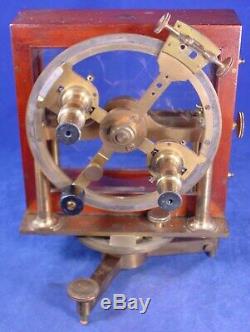

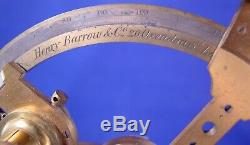
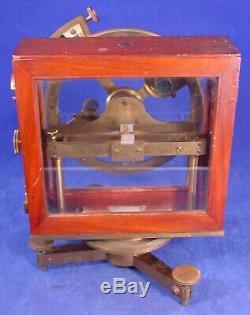


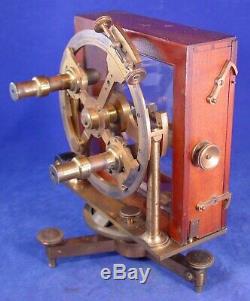
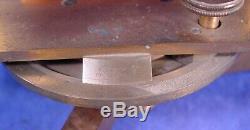

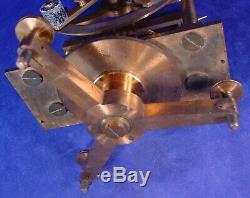

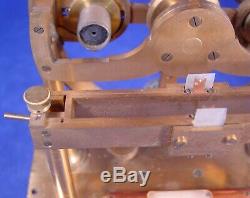

Henry Barrow and Company Kew pattern dip circle that I believe was set up for a Creak total force attachment which is now missing, made circa 1850. The horizontal circle measures 5 1/2 inches diameter and is graduated and read by vernier. The glass & wood box measures 7 inches square and the instrument stands 9 1/2 inches tall. It is my understanding that some examples of these instruments were placed on gimbaled tables and put on sailing ships to be taken all over the globe measuring the magnetic variation that was so critical to navigation back then.
Unfortunately this instrument is missing the primary magnetic needle (there is an extra one that appears correct for this instrument at the Royal Musuems Greenwich in England if you can talk them out of it), and the horizontal locking thumb screw is missing. As I mentioned because there are some additional holes on the vernier arm, I think this is set up for a.
Creak total force attachment which is now missing. There is an excellent paper written by Jane Insley entitled. MAKING MOUNTAINS OUT OF MOLEHILLS? GEORGE EVEREST AND HENRY BARROW, 1830-39 that I can sent or you can find with a google search. Here is some information on the well respected maker Henry Barrow.Henry Barrow & Company Dip Circle. Henry Barrow and Company Kew pattern dip circle that I believe was set up for a Creak total force attachment which is now missing. The horizontal circle is graduated and read by vernier. Some examples of these instruments were placed on gimbaled tables and put on sailing ships to be taken all over the globe measuring the magnetic variation that was so critical to navigation back then. Henry Barrow, instrument maker, is represented in the Science Museum's collections by at least eleven instruments, including dip circles, transit theodolites and actinometers, He is also known to have supplied the principal precision balance used for re-establishing the British standards of weights and measures after their destruction by fire, as described by John Stock'.
Barrow does not appear in trade directories before 1845, and his career path before these instruments were made was somewhat unusual. Barrow might have been apprenticed to either George Dollond or Edward Troughton as he did work for both of them before 1829. Barrow was appointed MIM under the Surveyor General of India (1830-39); succeeded to the business of Thomas Charles Robinson in 1842; became "Robinson and Barrow" (1842-50); also made balances; invented a new dip needle. The main London workshops of the beginning of the 19th century are well known by name, but much remains to be demonstrated about the way they were run.
One aspect which is becoming increasingly clear is the use of sub-contracted labor from both London and the provinces, and until 1830 Henry Barrow was a contract laborer. He was the first Mathematical Instrument Maker chosen by George Everest to set up and run a workshop for the repair of defective equipment for the Survey of India. Everest's first choice was Henry Barrow. They appear to have met in January 1829, through William Richardson, an assistant at the Royal Observatory in Greenwich, who was helping Everest with calculations for the Meridional Arc measurements. Barrow's appointment to the post of Mathematical Instrument Maker was dependant on the provision of suitable testimonials. Soon after becoming Superintendent of the U. Making Mountains out of Molehills?George Everest and Henry Barrow 1830-39. By Jane Insley Indian Journal of History of Science 30 (1). Henry Barrow was the first Mathematical Instrument Maker chosen by George Everest to set up and run a workshop for the repair of defective equipment for the Survey of India.
GEORGE EVEREST AND HENRY BARROW, 1830-39. In an attempt to reduce the cost and delay to the work of the Survey of India because of defective equipment, George Everest decided in 1830 to establish a workshop for repairs in Calcutta. The first Mathematical Instrument Maker chosen to set up and run this workshop was Henry Barrow, a respected but minor figure in the London trade. During the nine years of Barrow's tenure, the relationship between the two men was far from easy. Everest pushed forward the survey and the measurement of a meridional arc with instruments maintained by Barrow and his workforce, and the final straw for the two men was the problem of converting the field observation instruments for use in a fixed observatory at Kaliana. However, he does not appear in trade directories before 1845, and his career path before these instruments were made was somewhat unusual. My main focus though for this paper is on the time Barrow spent as the Mathematical Instrument Maker to the Honorable Court of Directors of the East India Company. The background to this is somewhat more complicated than Stock described it', but briefly the story goes like this. George Everest became head of the Great Trigonometrical Survey of India on the death of his predecessor in 1823. The instruments available to him included the third of the three foot theodolites to be made, a copy of the original Ramsden design made by Cary. This theodolite had been badly damaged during an attempt to haul it to the top of a pagoda for trigonometrical observations, and although field repairs had been carried out, it was in a very sorry state. Everest was invalided back to Britain in 1825, so ill he was not expected to live; happily he survived, and took the opportunity to join the Royal Society and to follow up contacts.He familiarized himself with the work of the Ordnance Survey, particularly in Ireland, and investigated the London workshops with a view to bringing the equipment of the Survey of India up-to-date. He received funds from the Court of Directors for two astronomical circles (one called Troughton the other Simms), another three foot theodolite now in Calcutta, and other instruments. He hijacked two sets of compensation bars for baseline measurements which had been ordered by the Bengal Engineers.
And he also devised a small revenue theodolite which he christened the Honorable East India Company theodolite, and which has been known as the Everest theodolite ever since -the story of that is in press at the time of writing. But new kit alone was not enough to keep the Survey going. There was a massive need to carry out repairs. With this in mind he again applied to the Court for funds, and again was successful. 15 Dec 1829 Resolved by the Ballot, that this court concurring with Captain Everest who has now been appointed Surveyor General of India, in his view of the advantages to be derived both in point of efficiency and economy, from sending to India in the Company's service for temporary employment, a professional mathematical instrument maker, to be placed under the direction and orders of the Surveyor General... Everest had wanted Richardson to take the post of Astronomer at Madras Observatory, but Richardson had a medical condition which rendered him unable to undertake the work. He was a blacksmith turned self-taught mathematician of some potential, and he and Henry Barrow both baptized children at St Ann's Church, Soho -they were near neighbors. A blacksmith would be a useful contact for a contract instrument maker to have. Although the originals have not been found in the India Office Library and Records, it is recorded that they were received by the Committee of Correspondence from the Astronomer Royal, Mr Troughton, Mr Simms, Mr Dollond, Mr Riddle, and Messrs Watkins and Hill -it is reasonable to assume that these were in some sense at least satisfied customers. The testimonials would also be potentially fascinating in revealing more detail of the trade at that time.6 Everest's high opinion of Barrow at this stage was summarized in a note written on 4 Nov 1830 and preserved in the archives of the Survey of India in Delhi. I found him an intelligent clever person, one of the principal workers of the trade his character stood exceedingly high with the most eminent opticians in London, for ability, punctuality and unimpeachable integrity, and from the profits of his employment by Troughton, Dollond, Jones Watkins and others, he cleared between 300 and 4006 per year. There are few persons in England who so situated would have been induced to quit their native country on a doubtful speculation, but Mr Barrow had a wife and six children and he felt I presume what every man of innate talent must more or less feel when he finds himself kept down below his natural level in society by the want of capital to set up for himself, besides which there was a considerable leaven enthusiasm in his character, for he had by way of amusement erected a small observatory on the roof of his house at his own expense, and stocked it with instruments of his own making. Concern was expressed at whether Barrow, then aged about 39, would be able to cope with the Indian climate.
Everest felt that the Presidency of Bengal was a much healthier place than it used to be and that "Mr Barrow may, as he is a person of temporate habits manage with proper precaution to guard against the effects of its existing climate"(7, also). The same would prove not to be true for his second son William and his wife Elizabeth, both of whom died and were buried in Calcutta. The Committee agreed to Barrow's appointment on 22 Dec 1829. This estimate, for a set of professional tools, would also be fascinating, not only in its own right, but also for comparison with equipment lists that Barrow later had to complete after taking up his office.
Barrow must have had his own tools (to make the observatory and his own instruments) but either kept them apart or stored them in England. It is not clear either whether this estimate was just for Barrow's tools or for the whole workshop.The primary sources of information for Barrow's time in India are the many volumes of correspondence in the Survey of India Archive in the National Archive in Delhi. An invaluable guide to this labyrinth is H R Phillimore's monumental work Historical notes of the Survey of India; my personal entry was through the single volume of correspondence from Barrow as MIM to the Surveyor General's office, from 1830 to 18399 This volume contains 157 items spanning the entire period of Barrow's employment, and my reading of it was aided by the simultaneous reading of the other side of the correspondence by Jim Smith of the Royal Institution of Chartered' Surveyors. In the course of six hours, I was not able to take fully comprehensive notes of all items, but there were several sections that stood out as being worthy of further attention.
These concerned the assessment of premises for suitability as workshops, the questions Barrow had about local availability of materials, skills, workmen and the staffing of his own workshop, the catastrophic row between the two -men in February 1832, the lists of tools required in the workshop, and the final heartbreak of the attempts to convert under field conditions, the two astronomical circles from field instruments to observatory use. In this paper, only some of this material can be covered. Henry Barrow had several questions on his arrival in Calcutta. The first few concerned brass and its usefulness for casting.
He was told the composition was the same as in England, copper and zinc, the proportions being varied "as they want hard or soft metal". Casting moulds were made of clay rather than sand, but the castings were very good, and the quality was suitable for mathematical instruments. Barrow was also advised that, of the native workmen, the armourers might with training become useful; and that the foundry at the Arsenal would afford every facility for casting articles in brass. A suggested complement for his workshop was 4 armourers, I turner, I carpenter, and 1 Durman. In his subsequent formal application to Everest for staff, Barrow requested three other people; a writer, to keep accounts, to record the receipt and issue of instruments and materials, to produce quarterly reports, to deal with correspondence, and most importantly of all as an interpreter.A peon was needed to carry letters and messages and to run errands, and a sweeper was considered quite indispensable, as otherwise the filth and rubbish would accumulate to an extent unendurable by the people and highly injurious to the instruments under repair. An initial problem for Barrow was that he did not understand the native languages. Everest did, and would pop into the workshop several times a day when he was in Calcutta to see how things were going. In due course, this probably contributed to the disagreement between them. On 21 February 1832, Everest called in at the workshops with another officer, and started to examine the work in progress.
As part of the subsequent disciplinary procedure, Everest wrote an account of the ensuing conversation, and reported it as nearly as possible word for word to Col Casement, representing the Government of the Bengal Presidency. Mr Barrow was not in the shop at the time, but came down shortly afterwards; after looking at different parts of the various apparatus, on which the Artificers had been engaged, I said (with reference to one of the new boards made with 3 brass cups each for the microscopes) addressing myself to Mr Barrow. These cups seem to me to be of so simple a construction that I should think it might be possible to get them done out of the house by contract in the way done by Troughton & Simms and other Mathematical Instrument Makers in England don't you think it might be done Mr Barrow?
Where there are so many articles all alike, if it were possible it would be much cheaper to Government. Mr Barrow replied to this not incivilly at first, he thought it might be possible but that he could not manage it, and perhaps I might. He continued however to talk on upon the subject, and as he talked he gradually got angry without any cause that I could divine and assumed an insolent and dictatorial [manner] towards me as if determined to pick a quarrel with me.I do not pretend to recollect all he said, but amongst others I particularly remember him saying in a very surly tone,'Yes, if natives can do these kind of things, what's the use of my being sent out Mathematical Instrument Maker? I replied to this it is too late to think of that now -though the natives may be competent to making screws and other small matters, which do not require any very fine work, it does not follow that they are equal to all the nicer and more delicate parts of Mathematical Instruments.
Mr Barrow replied in the angry voice of a low tradesman you said they could make microscopes. I was startled at a declaration so full of effrontery, inputting to me an assertion so totally contrary to my opinion, and paused for a moment to trace back in my recollection what he could possibly allude to.A moment's recollection brought to my mind the only expressions which I had ever uttered, that could have been tortured to such a meaning, and they occurred in a conversation with Mr Barrow about a twelve month ago, when he himself in an allusion to the microscopes on which the Artificers were then engaged, said how different things were between this and England: that in England Mathematical Instrument Makers never make their own microscopes, but employed people out of the house to construct them by the job -on which I said what a pity it is that system cannot be followed up here, yet these microscopes seem almost as well made as English ones -do you think you could ever contrive to get them done here by natives out of the house? On his expressing his opinion in the negative, I dropped the subject, and never after revised it. This was now tortured by Mr Barrow into an assertion made by me that natives could make microscopes. Everest followed this complaint with a written set of rules and regulations, most of which Barrow accepted with fair grace, but he fell that his authority within his own workshop had been undermined. Some of the many reports stipulated have survived, along with his remark at one point that he would prefer to send repaired instruments rather than reports.
The workshop continued to function, and the notes record the return of Revenue survey kit to Mr Logan, a barometer to Everest himself with a comparison to Barrow's own, an order for lenses to be forwarded to Troughton and Simms, and the disassembly of the Cary three foot theodolite. New perambulators to Everest's own design were held up for lack of sufficient information.
In December 1832, 45 double wheeled perambulators arrived from Fort William to be converted to a single-wheeled form. The work on the Cary theodolite was eventually finished on July 1835, to everyone's relief, and to such good effect that subsequently it became known as the Barrow theodolite. On 22 July 1837, Barrow was ordered to hand over his workshop to Mr de Penning and to transfer via Everest's headquarters at Dehra Dun to Kaliana. This was the chosen site for a small permanent observatory to house the astronomical circles from the trigonometrical survey. Barrow wrote cheerfully to Everest on 30 October that despite being unable to get tools or workmen locally, he was confident that he would be able to complete the required alterations with the means at his disposal. The field party had built an enclosure 20 feet long and 7 feet wide with mud walls, to accommodate casting and forging. A model had been dispatched to Allahabad, for the casting of parts required at a later stage.By 15 December, it had all gone horribly wrong. Sir, it is with regret I have to report for your information that in annealing the four pillars for the three feet astronomical circles, three out of the four were unfortunately melted and are consequently rendered useless.
To remedy as much as possible this disastrous circumstance Kusiali proposed getting similar Pillars made at Futtyghar and that he would return with them within a month -As Mir Mohsin assured me that it was perfectly practicable, I have sent him to Futtyghar for that purpose, but as it is desirable to guard against any disappointment that might possibly occur, I beg to enclose an Indent for 4 plates of sheet brass on the Arsenal of Fort William. I have the honor to be &c. Nine months of labor problems, failure of supplies and personality clashes followed. By 19 November, Barrow was ready to admit defeat, and wrote. I have the honor to be. I have the honor to inform you that the two 3 feet Astronomical circles are mounted... In the Observatory and are in working order. I much regret to add that the vibratory motion of which you complained in the original construction of these instruments still remains. Letters were exchanged on a daily basis concerning various ways of remedying this.Settling for the turning away of half the bearing of the steel cone at the lower part. Not that I expect the result will be an instrument totally free from stiffness and [recessive] motion for the immense weight of the superstructure appears to me a great obstacle to that result, for when the upper structure is removed the motion of the axis is freer than I as a Mathematical Instrument maker should deem prudent.
Everest for once fore bore to comment on this as he felt. It required the mechanical genius of a Ramsden to devise this form of axis, and matters in which that wonderful man seems to have met with entire success are certainly never destined to be improved by any suggestion of mine or to need my opinion in their confirmation. Now I hope I shall be excused for saying that I think it would have been quite as well if you had the same distrust of your mechanical powers, before you had altered the 3 feet circles by Troughton who as a Mathematical Instrument Maker stood pre-eminent. I have the honor to remain sir. This rebellion was consolidated in a further row.
Sir, I have the honor to acknowledge the receipt of your letter of yesterday's date and copy of your report as Superintendent of the Great Trigonometrical Survey of India to yourself as Surveyor General of India, and cannot but regret that the two divisions you mention are injured. I can only account for the injury by supposing that the circle was struck in lifting it in or out of its Y's -I believe the same has happened before as their sic 1 are other divisions injured. With regard to sitting in the observatory with my hat on, 1 beg to observe that it is quite within my recollections that in the season 1837138 that not only your assistants wore their hats but smoked cigars in your presence, and at this time of year it is hardly possible to remain in the Observatory when the apertures are open without some kind of [covering] on the head, and with reference to my being in the Observatory uncalled for. Generally speaking I have never evinced any great anxiety to obtrude myself in your presence. By 3 February 1839 he was on his way home. Although Barrow's departure from India took place under awkward circumstances, his reputation as a MIM was undiminished. The earliest reference to his return to London is August 1842, when he took over the Robinson workshop and business, and advertised for work. II He undertook further prestige projects such as the precision balance hunted by John Stock, two 24 theodolites for Everest's successor Andrew Waugh, and three sets of magnetic instruments to the specification of Sabine and Kew Observatory. He became a Fellow of the Royal Astronomical Society in 1849, and by the end of the 1860s was living in peaceful retirement in Westfield in Sussex, where he died in 1870 in his eightieth year12 His son Henry became an instrument maker also, joined him in business. His son Francis trained as a solicitor, and became an Appeal Agent for the India Privy Council.His daughter Henrietta also outli ved him, and inherited 61000 from an estate worth just under 65000. Further details remain to be clarified -a second marriage, the exact places of his residences and premises, and other family information. In summary, what can be made of Henry Barrow?
His early career is relatively obscure, as he was held back for want of capital to set up on his own. His adventurous but strongly independent nature took him and his family to India for 9 years, cost him a wife and a son, but led him to extend a five year contract to nine years in order to complete the tasks he had set himself.He worked for an ambitious bulldozer of a man on one of the largest scientific ventures of the day, maintaining observational apparatus that in some instances was of a style that was 50 years old. He consolidated his reputation for high precision, one-off laboratory and observatory pieces and passed on a business to his son to continue after his death. He could have disappeared without trace, but because his profile was just high enough, his career offers a glimpse of the possibilities open to those who were not an integral part of the large London Workshops, but whose work underpinned them. The item "1850 Henry Barrow & Co.
Kew Pattern Dip Circle, Magnetic Variation for Compass" is in sale since Thursday, June 20, 2019. This item is in the category "Antiques\Science & Medicine (Pre-1930)\Scientific Instruments\Other Antique Science Equip". The seller is "klony" and is located in Kalispell, Montana. This item can be shipped worldwide.

